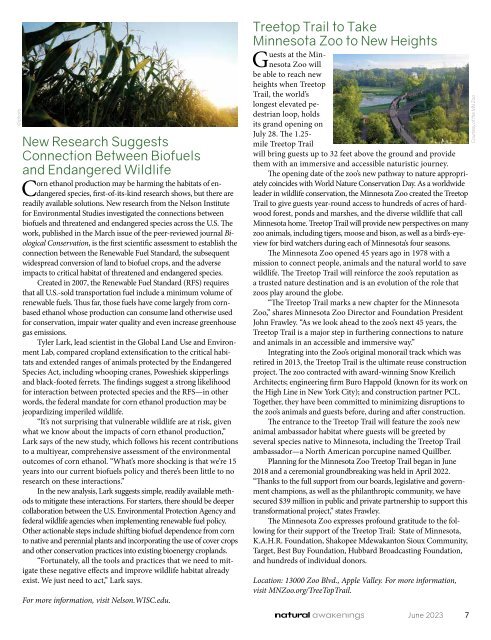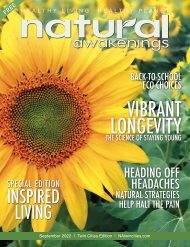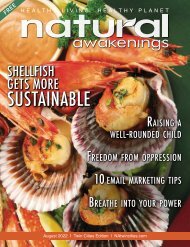Natural Awakenings Twin Cities June 2023
Read the June 2023 edition of Natural Awakenings Twin Cities magazine. This is our annual Men's Health Issue which features articles on taking conscious fatherhood, sexual vitality at every age, choosing sustainable stocks and mutual funds, living healthy to 100 and beyond, water consumption, rise in children with autism, artificial intelligence and so much more! Be sure to check out our local content, including News Brief announcements, Community Resource Guide with providers throughout the metro who can meet your individual wellness needs, and all the happenings in the Calendar of Events. There is additional online-only content that can be found at NATwinCities.com.
Read the June 2023 edition of Natural Awakenings Twin Cities magazine. This is our annual Men's Health Issue which features articles on taking conscious fatherhood, sexual vitality at every age, choosing sustainable stocks and mutual funds, living healthy to 100 and beyond, water consumption, rise in children with autism, artificial intelligence and so much more!
Be sure to check out our local content, including News Brief announcements, Community Resource Guide with providers throughout the metro who can meet your individual wellness needs, and all the happenings in the Calendar of Events. There is additional online-only content that can be found at NATwinCities.com.
Create successful ePaper yourself
Turn your PDF publications into a flip-book with our unique Google optimized e-Paper software.
©iphoto<br />
New Research Suggests<br />
Connection Between Biofuels<br />
and Endangered Wildlife<br />
Corn ethanol production may be harming the habitats of endangered<br />
species, first-of-its-kind research shows, but there are<br />
readily available solutions. New research from the Nelson Institute<br />
for Environmental Studies investigated the connections between<br />
biofuels and threatened and endangered species across the U.S. The<br />
work, published in the March issue of the peer-reviewed journal Biological<br />
Conservation, is the first scientific assessment to establish the<br />
connection between the Renewable Fuel Standard, the subsequent<br />
widespread conversion of land to biofuel crops, and the adverse<br />
impacts to critical habitat of threatened and endangered species.<br />
Created in 2007, the Renewable Fuel Standard (RFS) requires<br />
that all U.S.-sold transportation fuel include a minimum volume of<br />
renewable fuels. Thus far, those fuels have come largely from cornbased<br />
ethanol whose production can consume land otherwise used<br />
for conservation, impair water quality and even increase greenhouse<br />
gas emissions.<br />
Tyler Lark, lead scientist in the Global Land Use and Environment<br />
Lab, compared cropland extensification to the critical habitats<br />
and extended ranges of animals protected by the Endangered<br />
Species Act, including whooping cranes, Poweshiek skipperlings<br />
and black-footed ferrets. The findings suggest a strong likelihood<br />
for interaction between protected species and the RFS—in other<br />
words, the federal mandate for corn ethanol production may be<br />
jeopardizing imperiled wildlife.<br />
“It’s not surprising that vulnerable wildlife are at risk, given<br />
what we know about the impacts of corn ethanol production,”<br />
Lark says of the new study, which follows his recent contributions<br />
to a multiyear, comprehensive assessment of the environmental<br />
outcomes of corn ethanol. “What’s more shocking is that we’re 15<br />
years into our current biofuels policy and there’s been little to no<br />
research on these interactions.”<br />
In the new analysis, Lark suggests simple, readily available methods<br />
to mitigate these interactions. For starters, there should be deeper<br />
collaboration between the U.S. Environmental Protection Agency and<br />
federal wildlife agencies when implementing renewable fuel policy.<br />
Other actionable steps include shifting biofuel dependence from corn<br />
to native and perennial plants and incorporating the use of cover crops<br />
and other conservation practices into existing bioenergy croplands.<br />
“Fortunately, all the tools and practices that we need to mitigate<br />
these negative effects and improve wildlife habitat already<br />
exist. We just need to act,” Lark says.<br />
For more information, visit Nelson.WISC.edu.<br />
Treetop Trail to Take<br />
Minnesota Zoo to New Heights<br />
Guests at the Minnesota<br />
Zoo will<br />
be able to reach new<br />
heights when Treetop<br />
Trail, the world’s<br />
longest elevated pedestrian<br />
loop, holds<br />
its grand opening on<br />
July 28. The 1.25-<br />
mile Treetop Trail<br />
will bring guests up to 32 feet above the ground and provide<br />
them with an immersive and accessible naturistic journey.<br />
The opening date of the zoo’s new pathway to nature appropriately<br />
coincides with World Nature Conservation Day. As a worldwide<br />
leader in wildlife conservation, the Minnesota Zoo created the Treetop<br />
Trail to give guests year-round access to hundreds of acres of hardwood<br />
forest, ponds and marshes, and the diverse wildlife that call<br />
Minnesota home. Treetop Trail will provide new perspectives on many<br />
zoo animals, including tigers, moose and bison, as well as a bird’s-eyeview<br />
for bird watchers during each of Minnesota’s four seasons.<br />
The Minnesota Zoo opened 45 years ago in 1978 with a<br />
mission to connect people, animals and the natural world to save<br />
wildlife. The Treetop Trail will reinforce the zoo’s reputation as<br />
a trusted nature destination and is an evolution of the role that<br />
zoos play around the globe.<br />
“The Treetop Trail marks a new chapter for the Minnesota<br />
Zoo,” shares Minnesota Zoo Director and Foundation President<br />
John Frawley. “As we look ahead to the zoo’s next 45 years, the<br />
Treetop Trail is a major step in furthering connections to nature<br />
and animals in an accessible and immersive way.”<br />
Integrating into the Zoo’s original monorail track which was<br />
retired in 2013, the Treetop Trail is the ultimate reuse construction<br />
project. The zoo contracted with award-winning Snow Kreilich<br />
Architects; engineering firm Buro Happold (known for its work on<br />
the High Line in New York City); and construction partner PCL.<br />
Together, they have been committed to minimizing disruptions to<br />
the zoo’s animals and guests before, during and after construction.<br />
The entrance to the Treetop Trail will feature the zoo’s new<br />
animal ambassador habitat where guests will be greeted by<br />
several species native to Minnesota, including the Treetop Trail<br />
ambassador—a North American porcupine named Quillber.<br />
Planning for the Minnesota Zoo Treetop Trail began in <strong>June</strong><br />
2018 and a ceremonial groundbreaking was held in April 2022.<br />
“Thanks to the full support from our boards, legislative and government<br />
champions, as well as the philanthropic community, we have<br />
secured $39 million in public and private partnership to support this<br />
transformational project,” states Frawley.<br />
The Minnesota Zoo expresses profound gratitude to the following<br />
for their support of the Treetop Trail: State of Minnesota,<br />
K.A.H.R. Foundation, Shakopee Mdewakanton Sioux Community,<br />
Target, Best Buy Foundation, Hubbard Broadcasting Foundation,<br />
and hundreds of individual donors.<br />
Location: 13000 Zoo Blvd., Apple Valley. For more information,<br />
visit MNZoo.org/TreeTopTrail.<br />
Courtesy of the MN Zoo<br />
<strong>June</strong> <strong>2023</strong><br />
7
















